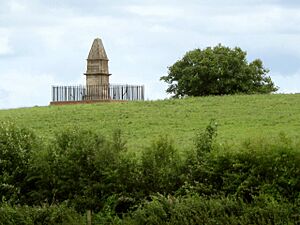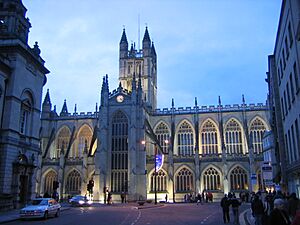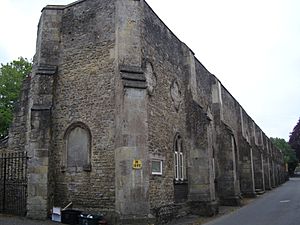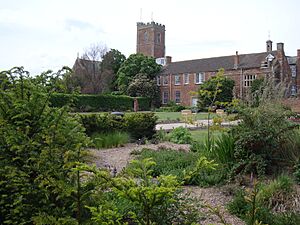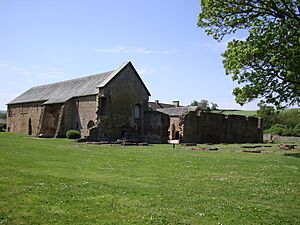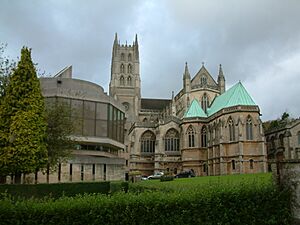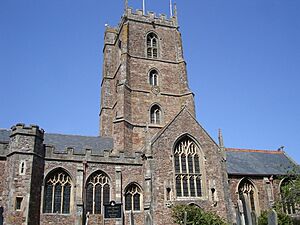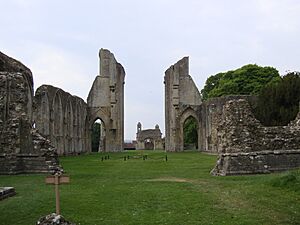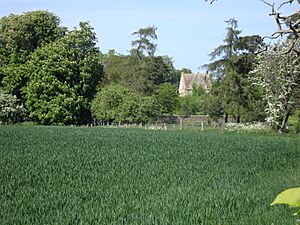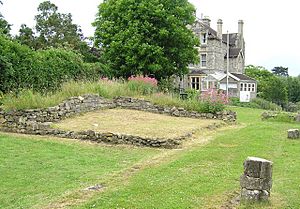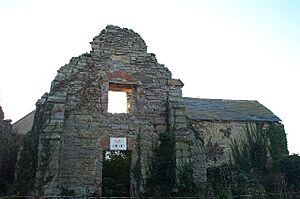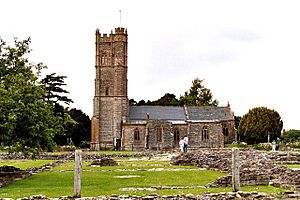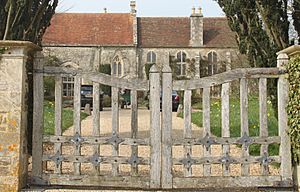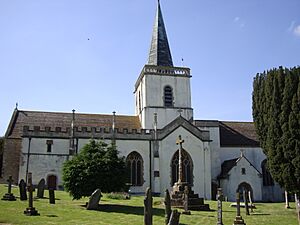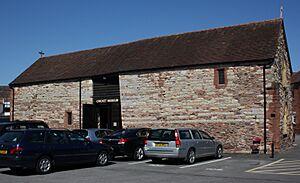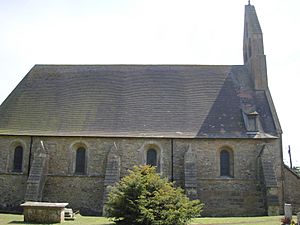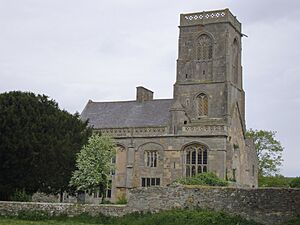List of monastic houses in Somerset facts for kids
Monastic houses were special places where groups of people, like monks or nuns, lived together. They dedicated their lives to religious practices, prayer, and often helped their local communities. These houses, which included abbeys, priories, and friaries, were very important in England, especially during the Middle Ages. They were centers of learning, farming, and charity.
Somerset, a county in England, was home to many of these monastic houses. Some were founded by kings, others by powerful families. Over time, many of them were closed down, especially during the 1500s when King Henry VIII changed the religion of England. Today, you can still find ruins or parts of these ancient buildings, which tell us a lot about history.
Alien houses are included, as are smaller establishments such as cells and notable monastic granges (particularly those with resident monks), and also camerae of the military orders of monks (Knights Templars and Knights Hospitaller). Monastic hospitals are included where they had the status or function of an abbey, priory, friary or preceptor/commandery.
- Abbreviations and key
| Symbol | Status |
|---|---|
| None | Ruins |
| * | Current monastic function |
| + | Current non-monastic ecclesiastic function (including remains incorporated into later structure) |
| ^ | Current non-ecclesiastic function (including remains incorporated into later structure) or redundant intact structure |
| $ | Remains limited to earthworks etc. |
| # | No identifiable trace of the monastic foundation remains |
| ~ | Exact site of monastic foundation unknown |
| ≈ | Identification ambiguous or confused |
Locations with names in italics indicate possible duplication (misidentification with another location) or non-existent foundations (either erroneous reference or proposed foundation never implemented) or ecclesiastical establishments with a monastic name but lacking actual monastic connection.
| EH | English Heritage |
| LT | Landmark Trust |
| NT | National Trust |
Contents
- Monastic Houses in Somerset
- Athelney Abbey
- Bablew Grange
- Banwell Monastery
- Barlinch Priory
- Barrow Gurney Nunnery
- Bath Abbey
- Brent Cell
- Bridgwater Greyfriars
- Bruton Abbey
- Buckland Priory
- Burtle Priory
- Cannington Nunnery
- Charterhouse on Mendip
- Clevedon Friary
- Cleeve Abbey
- Downside Abbey
- Dunster Priory
- Glastonbury Abbey
- Green Ore Cell
- Hinton Priory
- Ilchester Friary
- Ilchester Nunnery
- Keynsham Abbey
- Kilve Chantry
- Montacute Priory
- Muchelney Abbey
- Stavordale Priory
- Stogursey Priory
- Taunton Priory
- Templecombe Preceptory
- Witham Friary
- Woodspring Priory
- Yenston Priory
- Images for kids
- See also
Monastic Houses in Somerset
Athelney Abbey
Athelney Abbey might have started as a small hermitage around 878. It was formally founded by King Alfred around 888 for Benedictine monks. The abbey was dissolved in 1539. Today, a monument from 1801 marks the spot where the church once stood.
Bablew Grange
Bablew Grange was a small farm and chapel run by Cluniac monks. It was connected to Montacute Priory.
Banwell Monastery
This was a Saxon monastery. It was given to Asser by King Alfred around 888. St Andrew's Church in Banwell might be on the same site, though other locations are also possible.
Barlinch Priory
Barlynch Priory was founded for Augustinian Canons Regular between 1154 and 1189. It was dissolved before July 1537. Today, its remains are on the site of Barlynch Farm.
Barrow Gurney Nunnery
Barrow Gurney Nunnery was established for Benedictine nuns around 1200. It was dissolved in 1536. Its buildings were later used as part of Barrow Court.
Bath Abbey
Bath Abbey has a long history. It started as a Saxon nunnery around 676. It was rebuilt many times and became a home for Benedictine monks in 963/4. The abbey was dissolved in 1539. Today, the main church is still used by the local community.
Brent Cell
This was a small cell (a tiny monastery) for Benedictine monks. It was thought to be connected to Glastonbury Abbey.
Bridgwater Greyfriars
Bridgwater Greyfriars was founded for Franciscan Friars around 1245. Its church was consecrated in 1445 after being rebuilt. The friary was dissolved in 1538.
Bruton Abbey
Bruton Abbey might have started as an abbey for Benedictine monks around 1005. It was refounded for Augustinian Canons Regular between 1127 and 1135. It became an abbey in 1511 and was dissolved in 1539.
Buckland Priory
Buckland Priory had a complex history. It began as an Augustinian Canons Regular priory around 1166 but was dissolved quickly. It was then refounded around 1180 for the Knights Hospitaller, a military religious order. It also housed the Sisters of St John of Jerusalem. The site is now Buckland Farm.
Burtle Priory
Burtle Priory started as a hermitage in 1199. It became a priory cell for Augustinian Canons Regular connected to Glastonbury Abbey in 1267. It became independent in 1275 and was dissolved in 1536. The local church, St Philip and St James, now stands on the site.
Cannington Nunnery
Cannington Priory was founded for Benedictine nuns around 1138. It was dissolved in 1536. Parts of the original buildings are now part of Cannington Court.
Charterhouse on Mendip
This was a grange (a farm) for Carthusian monks, likely connected to Witham.
Clevedon Friary
Clevedon Friary is a modern Franciscan Friars Minor community that still exists today.
Cleeve Abbey
Cleeve Abbey was founded for Cistercian monks between 1186 and 1191. The building work started around 1198. It was dissolved in 1536.
Downside Abbey
Downside Abbey is a modern Benedictine monks community. The original community was founded in Douai in 1607 and moved to Downside in 1814.
Dunster Priory
Dunster Priory was founded for Benedictine monks around 1100 and was connected to Bath Abbey. It was dissolved in 1539. The church is still used today as the Priory Church of St George, Dunster.
Glastonbury Abbey
Glastonbury Abbey is one of the most famous monastic sites. It may have been founded for Saxon monks as early as the 6th century. It became a Benedictine monks abbey around 960. It was dissolved in 1539. Its impressive ruins are now open to the public.
Green Ore Cell
This was a small 'cell' for Benedictine monks, likely a farm or grange connected to Hinton Charterhouse.
Hinton Priory
Hinton Priory was home to Carthusian monks. The community moved here in 1232 from Gloucestershire. It was dissolved in 1539. Today, it is private property.
Ilchester Friary
Ilchester Blackfriars was a home for Dominican Friars, founded between 1221 and 1260. It was dissolved in 1538 and later demolished.
Ilchester Nunnery
Ilchester Nunnery started as a hospital around 1217-1220. It was refounded for Augustinian Canonesses before 1281 and dissolved before 1463.
Keynsham Abbey
Keynsham Abbey was founded for Augustinian Canons Regular around 1170. It was dissolved in 1539.
Kilve Chantry
Kilve Chantry was founded in 1329. It was damaged by fire in 1848.
Montacute Priory
Montacute Priory was founded for Cluniac monks between 1078 and 1102. It was dissolved in 1539. Its remains are now part of Abbey Farmhouse.
Muchelney Abbey
Muchelney Abbey was founded for Benedictine monks before 693. It was dissolved in 1538. Its ruins are now managed by English Heritage.
Stavordale Priory
Stavordale Priory was founded for Augustinian Canons Regular before 1243. It merged with Taunton Priory in 1533. The church building was later turned into a private house.
Stogursey Priory
Stogursey Priory was a home for Benedictine monks, founded between 1100 and 1107. It was an "alien house," meaning it was dependent on a monastery in France. It was given to Eton College in 1440.
Taunton Priory
Taunton Priory started as a religious college before 904. It was refounded for Augustinian Canons Regular around 1120. It was dissolved in 1539. Part of its remains are now a cricket museum.
Templecombe Preceptory
Templecombe Preceptory was a base for the Knights Templar, a military religious order, founded around 1185. After they were dissolved, it was given to the Knights Hospitaller in 1312. It was dissolved in 1539.
Witham Friary
Witham Friary was founded for Carthusian monks in 1178/9. It was dissolved in 1539. The church building is now used by the local parish.
Woodspring Priory
Woodspring Priory was founded for Augustinian Canons Regular. The community moved here before 1226. It was dissolved in 1539. Today, it is used as an exhibition center for artwork.
Yenston Priory
Yenston Priory was a small cell or farm for Benedictine monks, connected to a monastery in France. It was founded before 1090. It's unclear if it ever fully became a priory.
Images for kids
See also


